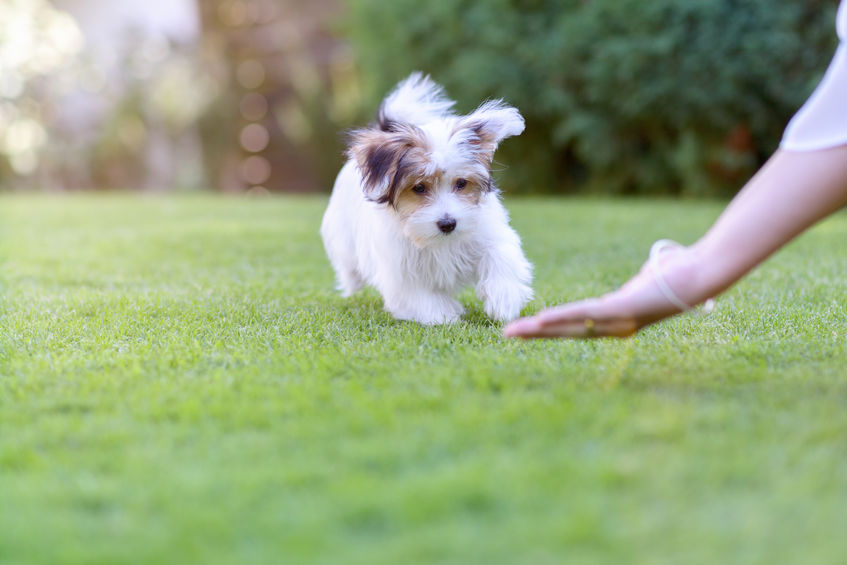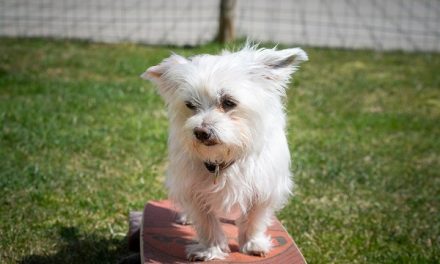Are Havanese dogs easy to train? Taking the time to answer this question before you make a lifelong commitment to a Havanese puppy is smart for your wellbeing and your new pup’s.
The truth is, some dog breeds are simply easier to train than others. A dog’s personality and temperament, background, breeding, health, and other factors can contribute to make some dogs more amenable to training and socialization.
In the case of the Havanese, a big reason for this breed’s ongoing widespread popularity comes from the ease with which they can be trained. But there is one important exception to this rule which we will talk more about in more detail here shortly.
So now let’s dive into the question are “Are Havanese easy to train?” so you know what you need to know to decide if this is the dog for you!

Are Havanese Dogs Easy to Train?
Happily, the short answer to this question is yes. The Havanese is a dog breed with a history that stretches back more than 300 years, giving breeders and owners access to a vast repository of data about this dog breed’s personality, temperament and overall trainability.
The Havanese is highly predisposed towards people-pleasing, a trait that other internationally popular dog breeds such as the Labrador Retriever also exhibit.
Overall, dogs with high scores in people-pleasing tend to be easier to train than dogs that are bred for the purposes of working independently (the Basenji and Akita are good examples of dogs that often follow their own counsel over that of their people).
What makes the Havanese naturally eager to please you? For starters, this dog was never bred to do any work at all! The Havanese breed got its start in Havana, Cuba, the city which gives this dog its breed name. For more than 300 years, the happy little Havanese warmed royal laps, receiving pats, praise, treats and more in return.
So for the modern Havanese, pleasing you is basically the canine version of a no-brainer.
Are Havanese Easy to Train to Do Tricks?
For many families, teaching the family dog to do tricks is one of the biggest joys your family will share together.
There are benefits for everyone, but especially for the younger family members, who gain confidence, coordination, social skills, and leadership skills from the experience of training a dog to do tricks and perform them on cue.
Hearing that the Havanese was bred to be a lap dog may make you wonder if this dog breed will want to learn to do tricks. Surprisingly, the answer here is also yes!
Havanese dogs love to learn tricks and they adore performing for their people and even for strangers (one of the reasons other than their long, gorgeous coats that they are also popular in the show ring).
However, there is one caveat which can make your Havanese dog less eager to learn tricks and perform them, which is what we will talk about next.
What Type of Training Method Is Best for Havanese?
The days (decades, really) of using “pack mentality” training methods – often referred to today as “negative reinforcement” training methods – are well and gone.
Negative reinforcement, or punishment-based training methods never really worked that well to start with, and they often produced unpredictable dogs that were poorly suited to life with a family and young children.
Positive reinforcement training, sometimes called “rewards-based” training, is much more successful in producing dogs that will make great family pets as well as great working canines.
Havanese are particularly intelligent, emotionally sensitive dogs who are instinctively tuned in to their people. Your Havanese will be able to sense your moods and wishes, which is why this breed is so frequently picked as a therapy dog.
A Havanese dog will respond very poorly to anything other than the most positive training methods. Here, “rewards” can mean treats and may also mean praise, pats, playtime, lap time and other rewards Havanese dogs crave and prize.
Using positive reinforcement training methods (clicker training with treats or pats is a great example of one popular method) will help you train your naturally responsive, smart and eager Havanese dog quickly and effectively.
Are Havanese Easy to Potty Train?
One common question new prospective Havanese owners often ask is “Are Havanese easy to potty train?”
In the introduction to this article, we mentioned there was one exception to the Havanese breed’s reputation of being easy to train. The exception is potty training, but not for the reasons you might expect
A fully-grown Havanese dog typically weighs between seven and 13 pounds. This weight range places the Havanese squarely in the toy dog breeds category. Toy dog breeds are amongst the most difficult breeds to potty train, because their bladders are just so tiny!
A Havanese puppy isn’t going to be able to “hold it” even as long as a small breed puppy will. This will mean more accidents on the road to potty training success.
In fact, everything about a Havanese puppy is smaller, including their stomach. This means more frequent feedings, more frequent drinks, more frequent trips to the puppy pads – this is just par for the course when you share your life with a toy breed pup.
Havanese puppy breeders recommend taking these extra steps to minimize the risk of accidents because your puppy simply can’t hold it any longer (these accidents are likely to upset both you and your puppy equally and as such are best avoided if possible):
– Choose a sufficiently roomy puppy training crate so your pup has space to sleep at one end and space to potty all the way at the other end.
– Make it very clear which spot is the “to go” bathroom spot both inside your puppy’s training crate and outside on the lawn.
– Offer an avalanche of praise and rewards every time your puppy goes successfully.
– Feed smaller meals more frequently to avoid too many accidents.
– Stop feeding (and potentially remove water) at least a few hours before bedtime to reduce the risk of night-time accidents.
– Study your puppy so you know the signs it is time to go out.
Because the Havanese dog breed is so easy to train otherwise, you have some potty training options with this dog breed that might not work with most other dog breeds.
Litter box potty training.
One option is to litter box train your Havanese. This is a particularly great option if you live in the city or in a high-rise where it is difficult to get your puppy outside quickly enough.
You can use supplies suitable for a large cat. Be sure to keep the litter box extremely clean to encourage your puppy to use it.
Bell training.
Some Havanese owners have had great success training their puppies to ring a bell as a signal they need to go out to potty. Any large resonant bell should work for this purpose – just be sure you hang it near the door and within your puppy’s reach.
Overall, the process of potty training a Havanese dog can take between six and eight months. This is about the amount of time it will take for your puppy’s bladder and bowel systems to finish developing, stabilize and help your dog control both functions.
So you may need to be prepared to exert a little bit of extra patience with this training process than you will with any other tasks you want your Havanese puppy to learn and master. But the reward will be a happy, healthy adult Havanese dog who can pretty much take care of their own elimination functions without trouble!
Are Havanese Easy to Train?
In this article, we have been exploring the personality, temperament, and trainability of the Havanese purebred dog breed.
This dog breed is a popular pick for service and therapy dog work. The Havanese is also the American Kennel Club’s 24th most popular purebred dog breed (out of 193 breeds)!
Havanese dogs have been bred for hundreds of years to be companions to people. While they look quite delicate, especially when wearing their long show coats, underneath this dog is strong and sturdy, a natural athlete and eager to learn tricks and commands and perform them on cue.
However, just as with all toy-sized dog breeds, a Havanese puppy can take longer to develop and master bladder and bowel function, making potty training the sole exception to their reputation as easy-to-train dogs.
So when it comes to potty training your Havanese, you can expect the process to take a bit longer than it would if you chose a bigger dog breed. Even so, you have some fun options, including litter box and bell training, that can help make training time more fun.
Overall, the Havanese dog is one of the easiest dog breeds for individuals and families to train.





Trackbacks/Pingbacks